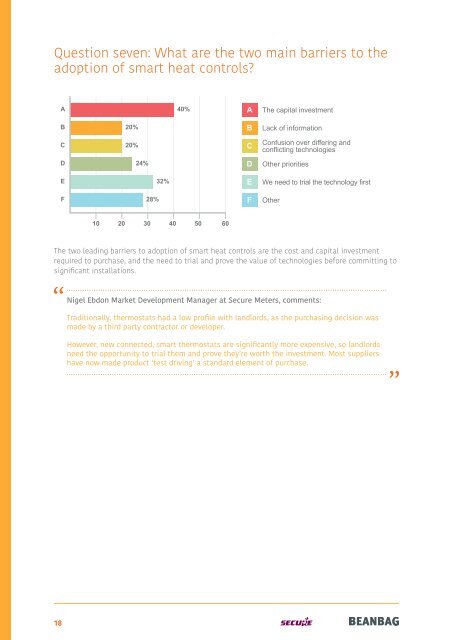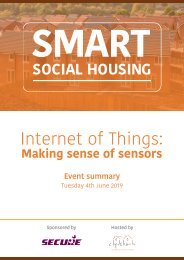The Internet of Things & Smart Heat Controls in Social Housing
The Internet of Things & Smart Heat Controls in Social Housing Market Intelligence Report 2020
The Internet of Things & Smart Heat Controls in Social Housing Market Intelligence Report 2020
Create successful ePaper yourself
Turn your PDF publications into a flip-book with our unique Google optimized e-Paper software.
Question seven: What are the two ma<strong>in</strong> barriers to the<br />
adoption <strong>of</strong> smart heat controls?<br />
Question eight: Can you rate the importance <strong>of</strong> the<br />
follow<strong>in</strong>g benefits <strong>of</strong> smart heat controls?<br />
1<br />
237<br />
1<br />
Support<strong>in</strong>g vulnerable tenants<br />
A<br />
40%<br />
A<br />
<strong>The</strong> capital <strong>in</strong>vestment<br />
2<br />
234<br />
2<br />
Reduc<strong>in</strong>g tenant fuel bills<br />
B<br />
C<br />
D<br />
20%<br />
20%<br />
24%<br />
B<br />
C<br />
D<br />
Lack <strong>of</strong> <strong>in</strong>formation<br />
Confusion over differ<strong>in</strong>g and<br />
conflict<strong>in</strong>g technologies<br />
Other priorities<br />
3<br />
4<br />
5<br />
231<br />
227<br />
223<br />
3<br />
4<br />
5<br />
Improv<strong>in</strong>g repairs and ma<strong>in</strong>tenance efficiency<br />
Us<strong>in</strong>g data to better manage your<br />
hous<strong>in</strong>g assets<br />
Improv<strong>in</strong>g customer service<br />
E<br />
32%<br />
E<br />
We need to trial the technology first<br />
6<br />
211<br />
6<br />
Increas<strong>in</strong>g environmental<br />
performance/efficiencies<br />
F<br />
28%<br />
F<br />
Other<br />
7<br />
209<br />
7<br />
Reduc<strong>in</strong>g costs<br />
10 20 30 40 50 60<br />
8<br />
205<br />
8<br />
Reduc<strong>in</strong>g CO 2<br />
<strong>The</strong> two lead<strong>in</strong>g barriers to adoption <strong>of</strong> smart heat controls are the cost and capital <strong>in</strong>vestment<br />
required to purchase, and the need to trial and prove the value <strong>of</strong> technologies before committ<strong>in</strong>g to<br />
significant <strong>in</strong>stallations.<br />
Nigel Ebdon Market Development Manager at Secure Meters, comments:<br />
Traditionally, thermostats had a low pr<strong>of</strong>ile with landlords, as the purchas<strong>in</strong>g decision was<br />
made by a third party contractor or developer.<br />
However, new connected, smart thermostats are significantly more expensive, so landlords<br />
need the opportunity to trial them and prove they’re worth the <strong>in</strong>vestment. Most suppliers<br />
have now made product ‘test driv<strong>in</strong>g’ a standard element <strong>of</strong> purchase.<br />
190 200 210 220 230 240 250<br />
Respondents were asked to score the importance <strong>of</strong> eight potential benefits <strong>of</strong> smart heat controls,<br />
allow<strong>in</strong>g perceived importance to be ranked.<br />
Interest<strong>in</strong>gly, the two most valued benefits are both related to tenant welfare, namely support<strong>in</strong>g<br />
vulnerable tenants and reduc<strong>in</strong>g fuel poverty.<br />
Fuel poverty rema<strong>in</strong>s a persistent problem <strong>in</strong> the UK, accord<strong>in</strong>g to the Department for Bus<strong>in</strong>ess,<br />
Energy & Industrial Strategy 2.53 million households are classified as fuel poor – that’s around<br />
10% <strong>of</strong> homes 5 .<br />
In its 2019 Fuel Poverty report, it highlights energy efficiency as one <strong>of</strong> three key solution drivers<br />
(along with <strong>in</strong>come and fuel prices).<br />
As higher energy efficiency reduces a household’s fuel costs then as a result a household is<br />
less likely to be classified as “high cost”. As fuel poor households get more energy efficient,<br />
they have lower costs required to heat their homes and so the gap also decreases.<br />
Although social homes tend to be more energy efficient than private rental sector properties,<br />
landlords are quick to <strong>in</strong>vest <strong>in</strong> technology that can further <strong>in</strong>crease efficiency – particularly <strong>in</strong> the<br />
face <strong>of</strong> ris<strong>in</strong>g fuel costs.<br />
<strong>The</strong> third placed benefit is improv<strong>in</strong>g repairs and ma<strong>in</strong>tenance efficiency, which is most likely l<strong>in</strong>ked<br />
to the remote monitor<strong>in</strong>g <strong>of</strong> boilers, allow<strong>in</strong>g landlords to prioritise those boilers and heat<strong>in</strong>g<br />
systems that are most likely to fail.<br />
5<br />
Annual Fuel Poverty Statistics <strong>in</strong> England, 2019 (2017 data), Department for Bus<strong>in</strong>ess, Energy & Industrial Strategy<br />
<strong>The</strong> <strong>Internet</strong> <strong>of</strong> <strong>Th<strong>in</strong>gs</strong> & <strong>Smart</strong> <strong>Heat</strong> <strong>Controls</strong> <strong>in</strong> <strong>Social</strong> Hous<strong>in</strong>g<br />
18 Market Intelligence Report 2020<br />
19







